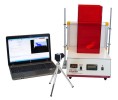Authors
I. Yalcin, A. Charlet, M.-J. Freund-Mercier, M. Barrot, P. Poisbeau.
Lab
Centre National de la Recherche Scientifique, Institut des Neurosciences Cellulaires et Intégratives, Nociception and Pain Department, Strasbourg, France.
Journal
The Journal of Pain
Abstract
In animal studies, thermal sensitivity is mostly evaluated on the basis of nociceptive reaction latencies in response to a given thermal aversive stimulus. However, these techniques may be inappropriate to differentiate allodynia from hyperalgesia or to provide information differentiating the activation of nociceptor subtypes. The recent development of dynamic hot and cold plates, allowing computer-controlled ramps of temperature, may be useful for such measures. In this study, we characterized their interest for studying thermal nociception in freely moving mice and rats. We showed that escape behavior (jumps) was the most appropriate parameter in C57Bl/6J mice, whereas nociceptive response was estimated by using the sum of paw lickings and withdrawals in Sprague-Dawley rats. We then demonstrated that this procedure allows the detection of both thermal allodynia and hyperalgesia after peripheral pain sensitization with capsaicin in mice and in rats. In a condition of carrageenan-induced paw inflammation, we observed the previously described thermal hyperalgesia, but we also revealed that rats exhibit a clear thermal allodynia to a cold or a hot stimulus. These results demonstrate the interest of the dynamic hot and cold plate to study thermal nociception, and more particularly to study both thermal allodynia and hyperalgesia within a single paradigm in awake and freely moving rodents. Perspective: Despite its clinical relevance, thermal allodynia is rarely studied by researchers working on animal models. As shown after stimulation of capsaicin-sensitive fibers or during inflammatory pain, the dynamic hot and cold plate validated in the present study provides a useful tool to distinguish between thermal allodynia and thermal hyperalgesia in rodents.
BIOSEB Instruments Used:
Cold Hot Plate Test (BIO-CHP),Jump Test (BIO-JTET)

 Douleur - Allodynie/Hyperalgésie Thermique
Douleur - Allodynie/Hyperalgésie Thermique Douleur - Spontanée - Déficit de Posture
Douleur - Spontanée - Déficit de Posture Douleur - Allodynie/Hyperalgésie Mécanique
Douleur - Allodynie/Hyperalgésie Mécanique Apprentissage/Mémoire - Attention - Addiction
Apprentissage/Mémoire - Attention - Addiction Physiologie & Recherche Respiratoire
Physiologie & Recherche Respiratoire
 Douleur
Douleur Métabolisme
Métabolisme Système moteur
Système moteur Neurodégénérescence
Neurodégénérescence Thématiques transversales
Thématiques transversales Système musculaire
Système musculaire Functions de motricité générale
Functions de motricité générale Troubles de l'humeur
Troubles de l'humeur Other disorders
Other disorders Joints
Joints Système Nerveux Central (SNC)
Système Nerveux Central (SNC)  Système sensoriel
Système sensoriel

